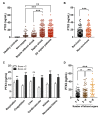Pentraxin-3 Is a Strong Biomarker of Sepsis Severity Identification and Predictor of 90-Day Mortality in Intensive Care Units via Sepsis 3.0 Definitions
- PMID: 34679604
- PMCID: PMC8534382
- DOI: 10.3390/diagnostics11101906
Pentraxin-3 Is a Strong Biomarker of Sepsis Severity Identification and Predictor of 90-Day Mortality in Intensive Care Units via Sepsis 3.0 Definitions
Abstract
Background: Sepsis is the leading cause of mortality in intensive care units (ICUs). However, early diagnosis and prognosis of sepsis and septic shock are still a great challenge. Pentraxin-3 (PTX3) was shown to be associated with the severity and outcome of sepsis and septic shock. This study was carried out to investigate the diagnostic and prognostic value of PTX3 in patients with sepsis and septic shock based on Sepsis 3.0 definitions.
Methods: In this single-center prospective observational study, all patients' serum was collected for biomarker measurements within 24 h after admission. Logistic and Cox regression analyses were used to identify the potential biomarkers of diagnosis, severity stratification, and prediction.
Results: Serum levels of PTX3 were significantly increased on the first day of ICU admission, while septic shock patients had highest PTX3 levels than other groups. A combination between PTX3 and procalcitonin (PCT) could better discriminate sepsis and septic shock, and PTX3 was an independent predictor of mortality in sepsis and septic shock patients.
Conclusion: PTX3 may be a robust biomarker to classify the disease severity and predict the 90-day mortality of sepsis and septic shock based on the latest Sepsis 3.0 definitions.
Keywords: biomarker; intensive care units; pentraxin-3; prognosis; sepsis; septic shock.
Conflict of interest statement
The authors declare no conflict of interest.
Figures






Similar articles
-
Diagnostic and prognostic value of interleukin-6, pentraxin 3, and procalcitonin levels among sepsis and septic shock patients: a prospective controlled study according to the Sepsis-3 definitions.BMC Infect Dis. 2019 Nov 12;19(1):968. doi: 10.1186/s12879-019-4618-7. BMC Infect Dis. 2019. PMID: 31718563 Free PMC article.
-
Pentraxin 3, a Predicator for 28-Day Mortality in Patients With Septic Shock.Am J Med Sci. 2017 Mar;353(3):242-246. doi: 10.1016/j.amjms.2017.01.003. Epub 2017 Jan 11. Am J Med Sci. 2017. PMID: 28262210
-
Pentraxin-3, procalcitonin and lactate as prognostic markers in patients with sepsis and septic shock.Oncotarget. 2017 Dec 26;9(4):5125-5136. doi: 10.18632/oncotarget.23701. eCollection 2018 Jan 12. Oncotarget. 2017. PMID: 29435167 Free PMC article.
-
Outcome of patients with sepsis and septic shock after ICU treatment.Langenbecks Arch Surg. 1998 Mar;383(1):44-8. doi: 10.1007/s004230050090. Langenbecks Arch Surg. 1998. PMID: 9627170 Review.
-
Proadrenomedullin in Sepsis and Septic Shock: A Role in the Emergency Department.Medicina (Kaunas). 2021 Sep 1;57(9):920. doi: 10.3390/medicina57090920. Medicina (Kaunas). 2021. PMID: 34577843 Free PMC article. Review.
Cited by
-
Long pentraxin 3 (PTX3) levels predict death, intubation and thrombotic events among hospitalized patients with COVID-19.Front Immunol. 2022 Oct 28;13:933960. doi: 10.3389/fimmu.2022.933960. eCollection 2022. Front Immunol. 2022. PMID: 36389697 Free PMC article.
-
Long Pentraxin 3 as a New Biomarker for Diagnosis of Hip and Knee Periprosthetic Joint Infections.J Clin Med. 2023 Jan 29;12(3):1055. doi: 10.3390/jcm12031055. J Clin Med. 2023. PMID: 36769703 Free PMC article.
-
Biomarkers of Oxidative Stress and Inflammation in Chronic Kidney Disease: A Cross-Sectional Study of Vitamin C and Pentraxin 3 Dynamics During Hemodialysis.Cureus. 2025 May 4;17(5):e83480. doi: 10.7759/cureus.83480. eCollection 2025 May. Cureus. 2025. PMID: 40470435 Free PMC article.
-
Immunosuppression in Sepsis: Biomarkers and Specialized Pro-Resolving Mediators.Biomedicines. 2024 Jan 13;12(1):175. doi: 10.3390/biomedicines12010175. Biomedicines. 2024. PMID: 38255280 Free PMC article. Review.
-
Time- and temperature-dependent Pentraxin 3 stability in serum and bronchoalveolar lavage fluid samples.Med Mycol. 2025 Jul 2;63(7):myaf057. doi: 10.1093/mmy/myaf057. Med Mycol. 2025. PMID: 40576635 Free PMC article.
References
-
- Singer M., Deutschman C.S., Seymour C.C., Shankar-Hari M., Annane D., Bauer M., Bellomo R., Bernard G.R., Chiche J.-D., Coopersmith C.C.M., et al. The Third International Consensus Definitions for Sepsis and Septic Shock (Sepsis-3) JAMA. 2016;315:801–810. doi: 10.1001/jama.2016.0287. - DOI - PMC - PubMed
-
- Coopersmith C.M., De Backer D., Deutschman C.S., Ferrer R., Lat I., Machado F.R., Martin G.S., Martin-Loeches I., Nunnally M.E., Antonelli M., et al. Surviving sepsis campaign: Research priorities for sepsis and septic shock. Intensiv. Care Med. 2018;44:1400–1426. doi: 10.1007/s00134-018-5175-z. - DOI - PMC - PubMed
LinkOut - more resources
Full Text Sources
Miscellaneous

